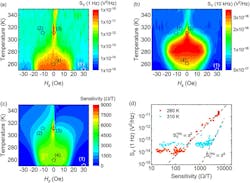Super-Sensitive Magnetic Sensor Leverages Hall-Effect Sibling
While most sensors that surround us and make modern technology possible are well-known and understood, magnetic sensors used in magnetometers are often overlooked or misunderstood, even though they’re critical to applications as small as gear-tooth sensing and as large as magnetic-resonance-imaging (MRI) systems. The quest for increasingly small yet sensitive magnetic-field sensors marches on, but sensitivity alone isn’t a sufficient qualifying parameter. That’s because sensor noise is often a limiting factor in low-level transducers.
With this in mind, researchers at Brown University developed a magnetic sensor that’s not only sensitive, but also exhibits very low noise. A device based on this research, which was supported by the National Science Foundation, could be part of a magnetic immunoassay arrangement, a technique that uses magnetism to look for pathogens in fluid samples. “Because the device is very small, we can put thousands or even millions of sensors on one chip,” said Brown graduate student Yiou Zhang, who was lead co-author along with postdoctoral researcher Kang Wang.
The principle behind their effort begins with the well-known Hall effect. However, it doesn’t end there. In the Hall effect, when a conductor or semiconductor with current flowing in one direction is introduced perpendicular to a magnetic field, a voltage can be measured at right angles to the current path. That small perpendicular voltage indicates the presence and magnitude of the magnetic field.
The Brown device uses a variation called the anomalous Hall effect (AHE), which occurs in ferromagnetic materials. The difference between the conventional Hall effect and the AHE is that while the Hall effect is due to the charge of electrons, the AHE arises from electron spin—the tiny magnetic moment of each electron. In the AHE, electrons with different spins orient in different directions, which gives rise to a small but detectable voltage. (The effect of magnetic fields on atomic particles is a source of many interesting phenomena: a similar effect related to emissions related to the magnetic moment of the hydrogen nucleus is the signal “source” captured by MRI systems.)
The device is fabricated as an ultra-thin ferromagnetic film made of cobalt, iron, and boron, and its electron spins “prefer” to have in-plane anisotropy; that is, to be aligned in the plane of the film (Fig. 1). However, once this film is heat-treated in a high-temperature furnace and subject to a strong magnetic field, the spins of the electrons tend to develop perpendicular anisotropy and thus will be aligned perpendicular to the film.
When those two anisotropies are equalized, the electron spins will easily reorient themselves if the material comes into contact with an external magnetic field, and this reorientation is sensed through AHE voltage. The resultant device is about 20X more sensitive than a comparable conventional Hall-effect sensor.
As with most such devices, there are tradeoffs in performance, and the thickness of the cobalt-iron-boron film is one of them. If the film is too thick, it will require a stronger magnetic field to reorient electron spins, leading to decreased sensitivity. Conversely, if it’s too thin, electron spins can reorient on their own, countering the usefulness of the sensor. The researchers found that a thickness of just 0.9 nm worked best.
In addition to achieving high sensitivity, reaching low intrinsic noise is also vital to attain good sensing performance. Magnetic anisotropy has a strong temperature dependence, which provides a way to fine-tune the effective magnetic anisotropy in a single magnetic sensor. The researchers performed comprehensive magnetotransport and noise characterization of the AHE sensor in the range of 250 K to 350 K and across four orders of magnitude of frequency from 1 Hz to 10 kHz. Using a physical property measurement system (PPMS) and tunable magnetic anisotropies, they observed and analyzed the interaction of 1/f noise and sensitivity, as well as the magnetic-field detectability.
Details of the sensor, device physics, fabrication process, measurement arrangement, tests process, and error-cancellation/correction factors are inherently complex. They’re discussed fully in their paper with the lengthy title “Noise characterization of ultrasensitive anomalous Hall effect sensors based on Co40Fe40B20 thin films with compensated in-plane and perpendicular magnetic anisotropies,” published in Applied Physics Letters (it’s behind a paywall but fortunately an unlocked version is downloadable here). While no single number can fully characterize device performance, the researchers note that with a small sensing area of 20 x 20 µm2, the magnetic field detectability reaches down to 76 nT/√Hz at 1 Hz and 2 nT/ √Hz at 10 kHz (Fig. 2).
About the Author

Bill Schweber
Contributing Editor
Bill Schweber is an electronics engineer who has written three textbooks on electronic communications systems, as well as hundreds of technical articles, opinion columns, and product features. In past roles, he worked as a technical website manager for multiple topic-specific sites for EE Times, as well as both the Executive Editor and Analog Editor at EDN.
At Analog Devices Inc., Bill was in marketing communications (public relations). As a result, he has been on both sides of the technical PR function, presenting company products, stories, and messages to the media and also as the recipient of these.
Prior to the MarCom role at Analog, Bill was associate editor of their respected technical journal and worked in their product marketing and applications engineering groups. Before those roles, he was at Instron Corp., doing hands-on analog- and power-circuit design and systems integration for materials-testing machine controls.
Bill has an MSEE (Univ. of Mass) and BSEE (Columbia Univ.), is a Registered Professional Engineer, and holds an Advanced Class amateur radio license. He has also planned, written, and presented online courses on a variety of engineering topics, including MOSFET basics, ADC selection, and driving LEDs.


